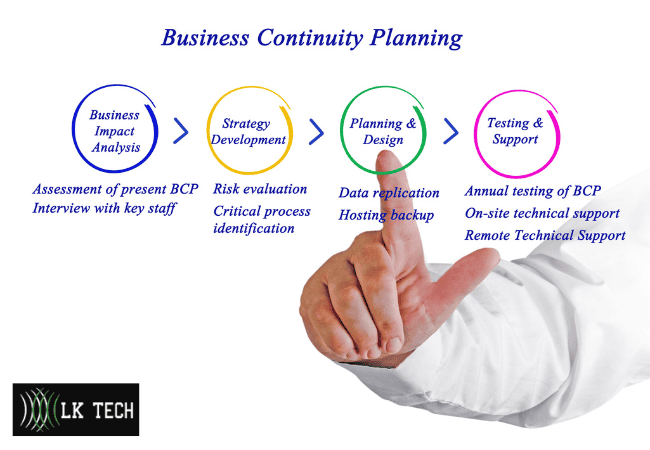In the unpredictable world of business, having a solid business continuity plan (BCP) is not just an option but a necessity. Whether it's weathering a storm or adapting to unexpected market shifts, a well-prepared BCP keeps companies resilient and operational.
Let's dive into some business continuity plan examples and key considerations for effectively safeguarding operations against disruptions.

What is a Business Continuity Plan?
A business continuity plan (BCP) is a documented set of procedures and strategies that outlines how an organization will continue its critical functions in the event of a disruption. It serves as a roadmap, guiding the organization through various contingencies and ensuring the continuity of operations.
The primary purpose of a business continuity plan is to provide a framework for effective response and recovery in the face of unexpected events. These events can range from natural disasters and cyberattacks to power outages and pandemics. By planning ahead and establishing protocols, organizations can minimize the impact of these disruptions and maintain essential services.
Benefits of Having a Business Continuity Plan
Having a robust business continuity plan offers numerous benefits to organizations of all sizes. Let's explore some of the key advantages:
- Minimizing Downtime and Financial Loss: A well-prepared BCP helps organizations minimize downtime during disruptions, reducing the financial impact of lost productivity, sales, and customer trust.
- Protecting Reputation and Customer Confidence: By swiftly and effectively responding to disruptions, organizations can demonstrate their commitment to customer satisfaction, maintaining their reputation and building trust.
- Ensuring Compliance: Many industries have regulatory requirements that mandate the development and implementation of business continuity plans. By having a BCP in place, organizations can ensure compliance and avoid potential legal and financial consequences.
- Enhancing Operational Resilience: A BCP enables organizations to identify vulnerabilities and implement measures to enhance their resilience. By proactively addressing potential risks, organizations can adapt and recover more effectively.
- Maintaining Supply Chain and Business Relationships: A well-prepared BCP considers the dependencies and interdependencies within the organization's supply chain and business relationships. By ensuring continuity in these areas, organizations can minimize disruptions and maintain critical partnerships.
- Boosting Employee Confidence and Morale: When employees know that their organization has a plan in place to navigate disruptions, it instills confidence and reassurance. This, in turn, boosts employee morale and productivity during challenging times.
While the importance of a business continuity plan cannot be overstated, it is equally important to regularly review and update the plan to reflect evolving risks, technology advancements, and organizational changes. By continuously refining the plan, organizations can ensure its effectiveness and readiness.

Elements of a Business Continuity Plan
A business continuity plan is a comprehensive strategy that helps organizations mitigate risks and ensure the continuity of their operations in the face of unforeseen events. This plan consists of several key elements that work together to protect the business and minimize potential disruptions. In this section, we will explore three essential elements of a business continuity plan: risk assessment and analysis, emergency response procedures, and backup and recovery strategies.
Risk Assessment and Analysis
Before developing a business continuity plan, conducting a thorough risk assessment and analysis is crucial. This process involves identifying potential risks and vulnerabilities that could impact the organization's operations. Understanding the specific threats that the business faces allows for the implementation of effective mitigation strategies.
During the risk assessment, businesses focus on key areas such as natural disasters, technological failures, cyber threats, and human factors. Evaluating the likelihood and potential impact of each risk allows organizations to prioritize their efforts and allocate resources accordingly. Regularly updating the risk assessment is essential to ensure the plan remains relevant and aligned with the evolving business landscape.
Emergency Response Procedures
In the event of a disruptive incident, having well-defined emergency response procedures is critical for minimizing the impact on business operations. These procedures outline the steps that should be taken to address the immediate aftermath of an incident and ensure the safety of employees, customers, and stakeholders.
Emergency response procedures should include clear protocols for evacuation, communication, and emergency services coordination. Assigning specific roles and responsibilities to designated individuals or teams helps streamline the response efforts. Regular training and drills are necessary to ensure that employees are familiar with the procedures and can act swiftly in an emergency situation.
Backup and Recovery Strategies
Data loss or system failures can significantly disrupt business operations. Implementing backup and recovery strategies is essential to safeguard critical information and facilitate the restoration of systems and processes. This includes regular backups of important data and the establishment of redundant systems to minimize downtime.
Businesses should develop a comprehensive data backup plan that includes both onsite and offsite backups. Onsite backups provide quick access to data, while offsite backups serve as a safeguard against physical damage or theft. It's important to regularly test the backup and recovery procedures to ensure their effectiveness and address any potential gaps.
When considering backup and recovery strategies, organizations should also evaluate the role of cloud services. Cloud-based solutions offer scalability, flexibility, and enhanced data protection. Exploring the benefits of the cloud for backup and recovery can provide businesses with additional resilience and peace of mind.
By incorporating risk assessment and analysis, emergency response procedures, and backup and recovery strategies into their business continuity plans, organizations can better prepare for potential disruptions. These elements work together to mitigate risks, ensure employee safety, and enable the swift recovery of operations. Remember, a well-developed and regularly updated business continuity plan is crucial for the long-term success and resilience of any organization.

Real-Life Business Continuity Plan Examples
To gain a better understanding of how business continuity plans can be implemented in different industries, let's explore three real-life case studies. These business continuity plan examples showcase the importance of having a robust business continuity plan in place and how it can help organizations navigate through unexpected disruptions.
Case Study 1: Retail Business
In this case study, a retail business faced a major disruption when a natural disaster struck their area, causing severe damage to their physical store. Thanks to their proactive approach to business continuity planning, the company was able to quickly recover and resume operations.
Some key elements of their business continuity plan included:
- Risk assessment and analysis: They conducted a thorough assessment of potential risks and identified the vulnerabilities specific to their retail environment.
- Emergency response procedures: The company had clear protocols in place to ensure the safety of their employees and customers during emergencies. This included evacuation plans, communication channels, and designated emergency response teams.
- Backup and recovery strategies: The retail business had implemented data backup systems and had off-site storage for critical inventory and customer data. This allowed them to quickly restore their operations and continue serving their customers, even in the aftermath of the disaster.
Case Study 2: Online Service Provider
In this case study, an online service provider experienced a significant cyberattack that resulted in a major outage. However, due to their well-developed business continuity plan, they were able to efficiently mitigate the impact and resume their services promptly.
Key aspects of their business continuity plan included:
- Risk assessment and analysis: The online service provider regularly assessed potential cybersecurity risks and implemented robust security measures to minimize vulnerabilities.
- Emergency response procedures: They had a designated incident response team trained to handle cyberattacks. Their plan included steps for isolating affected systems, mitigating the attack, and communicating with customers about the situation.
- Backup and recovery strategies: The company had implemented regular data backups and had redundant systems in place. This allowed them to quickly restore their services from a clean backup and minimize the downtime experienced by their customers.
Case Study 3: Manufacturing Company
In this case study, a manufacturing company faced a disruption when a critical piece of machinery failed unexpectedly, halting their production line. With their well-prepared business continuity plan, they were able to minimize the impact on their operations.
Key components of their business continuity plan included:
- Risk assessment and analysis: The manufacturing company identified the critical components of their production process and assessed the potential risks associated with each. This allowed them to prioritize their mitigation strategies.
- Emergency response procedures: The company had a trained maintenance team that could quickly diagnose and repair equipment failures. They also had established communication channels to inform relevant stakeholders, such as suppliers and customers, about the delay in production.
- Backup and recovery strategies: The manufacturing company had spare parts readily available for critical machinery, reducing the downtime caused by equipment failure. They also had contingency plans in place to address supply chain disruptions and ensure continuity in their operations.
These case studies highlight the importance of having a comprehensive business continuity plan tailored to the specific needs of different industries. By implementing risk assessments, emergency response procedures, and backup strategies, businesses can effectively navigate disruptions and minimize the impact on their operations.

Best Practices for Creating a Business Continuity Plan
Creating an effective business continuity plan is crucial for ensuring the resilience and continuity of your business operations. To help you develop a robust plan, here are some best practices to consider:
Involving Key Stakeholders
When creating a business continuity plan, it's important to involve key stakeholders from various departments within your organization. This includes representatives from management, IT, operations, human resources, and other relevant teams. By involving stakeholders from different areas, you can ensure that the plan addresses the specific needs and challenges faced by each department.
Collaboration and communication among stakeholders are essential during the planning process. Conducting regular meetings, workshops, and brainstorming sessions can help gather valuable insights and perspectives. This collaborative approach enhances the plan's effectiveness and ensures that all potential risks and impacts are considered.
Regular Testing and Updates
To ensure the effectiveness of your business continuity plan, regular testing and updates are crucial. Testing allows you to identify any gaps or weaknesses in the plan and provides an opportunity to refine and strengthen it. Through testing, you can evaluate the plan's feasibility, identify areas for improvement, and enhance your organization's preparedness.
There are various testing methods you can employ, such as tabletop exercises, simulations, or full-scale drills. These exercises help familiarize employees with their roles and responsibilities during an emergency, allowing for better coordination and response. By conducting regular tests, you can identify and address any changes or updates needed in the plan to adapt to evolving risks and technologies.
Communication Protocols
Effective communication is vital during times of crisis or disruption. Establishing clear communication protocols within your business continuity plan ensures that information flows smoothly and timely. This includes defining lines of communication, contact lists, and procedures for internal and external communication.
Internal communication should outline how employees will be notified of an incident, what channels will be used for updates and instructions, and how information will be disseminated throughout the organization. External communication protocols should cover how your organization will communicate with clients, suppliers, and other external stakeholders.
Maintaining up-to-date contact information for all stakeholders is essential. This includes contact details for employees, vendors, customers, and other relevant parties. Regularly reviewing and updating this information ensures that communication channels remain effective and accurate.
By following these best practices, you can create a robust business continuity plan that helps your organization navigate through disruptions and maintain operational continuity. Remember to involve key stakeholders, regularly test and update the plan, and establish effective communication protocols. This way, your business will be better prepared to respond to and recover from unexpected events.

Implementing Your Business Continuity Plan
Once you have developed a comprehensive business continuity plan, it is essential to effectively implement it within your organization. This section will cover three key aspects of implementing your business continuity plan: training employees, setting clear roles and responsibilities, and monitoring and evaluating the plan.
Training Employees
Training your employees on the specifics of your business continuity plan is crucial for its successful implementation. Conduct training sessions to educate your staff on the various procedures and protocols outlined in the plan. This includes familiarizing them with emergency response procedures, communication protocols, and the steps to be taken during a disruption.
During the training sessions, emphasize the importance of each employee's role in executing the plan. Provide them with the necessary resources and tools to effectively carry out their responsibilities. Encourage active participation and address any questions or concerns they may have. By ensuring that your employees are well-trained and informed, you can enhance their preparedness and response capabilities.
Setting Clear Roles and Responsibilities
To ensure a smooth implementation of your business continuity plan, it is crucial to establish clear roles and responsibilities for each employee. Assign specific tasks and duties to individuals or teams, clearly defining their areas of responsibility during a disruption. This includes designating leaders, coordinators, and contact points for different aspects of the plan.
Clearly outlining roles and responsibilities minimizes confusion and streamlines response efforts. Encouraging collaboration and communication among team members ensures effective coordination during a crisis. Regularly reviewing and updating these roles and responsibilities reflects changes in the organization or business continuity plan.
Monitoring and Evaluation of the Plan
Implementing a business continuity plan is an ongoing process that requires regular monitoring and evaluation to ensure its effectiveness. Establish a system for monitoring the plan's execution, including regular checks of critical infrastructure, communication systems, and backup strategies. This will help identify any potential gaps or areas for improvement.
Conduct periodic evaluations or tests to assess the plan's performance under simulated emergency scenarios. This can include tabletop exercises, simulations, or full-scale drills. Evaluate the response and recovery efforts, identify areas of improvement, and update the plan accordingly. Regularly communicate the results of these evaluations to relevant stakeholders and seek their input and feedback.
Continuously monitoring and evaluating your business continuity plan allows for necessary adjustments to enhance its effectiveness and adapt to changing circumstances. This proactive approach ensures your organization is well-prepared to respond to and recover from disruptions.
Implementing your business continuity plan requires a commitment to training, clear roles, and ongoing evaluation. By investing time and resources into these aspects, you can increase the likelihood of a successful response and minimize the impact of disruptions on your business.
Remember, a business continuity plan is not a one-time effort but an ongoing process. Regularly review and update your plan to account for changes in your organization, technology, and potential risks. By doing so, you can maintain a resilient and prepared organization in the face of any adversity.

Resources for Developing Business Continuity Plans
Creating a comprehensive business continuity plan can be a complex task, but fortunately, there are resources available to assist you throughout the process. Whether you need templates, professional guidance, or training programs, these resources can provide valuable support as you develop your business continuity plan.
Online Templates and Tools
Online templates and tools can be a great starting point for creating your business continuity plan. These resources offer pre-designed templates and customizable frameworks that can help you structure your plan effectively. By using these templates, you can save time and ensure that you cover all the necessary components of a business continuity plan.
- Template Library- Access a wide range of business continuity templates and frameworks to guide you through the planning process.
- Plan Development Tools- Utilize online tools that provide step-by-step guidance for developing your business continuity plan. These tools often include prompts and checklists to ensure you address critical areas.
Professional Consultation Services
For organizations seeking expert advice and guidance, professional consultation services can be invaluable. These services specialize in developing business continuity plans tailored to your specific industry and organizational needs. Consultants can provide insights, identify potential gaps in your plan, and offer recommendations for improvement.
- Business Continuity Consultants- Engage with experienced consultants who can assess your organization's unique requirements and help you develop a robust business continuity plan. These consultants often have extensive knowledge of industry regulations and best practices.
- IT Disaster Recovery Specialists- Collaborate with IT disaster recovery specialists who can evaluate your IT infrastructure, identify vulnerabilities, and design strategies to ensure the continuity of your critical systems and data.
Training and Certification Programs
To enhance your knowledge and skills in business continuity planning, consider enrolling in training and certification programs. These programs offer comprehensive courses that cover various aspects of business continuity, equipping you with the expertise to develop and implement effective plans.
- Business Continuity Training- Attend training sessions or workshops that cover business continuity planning methodologies, risk assessment techniques, and emergency response procedures. These programs often provide practical insights and real-world examples.
- Business Continuity Certification- Pursue professional certifications in business continuity management that validate your knowledge and expertise in the field. These certifications demonstrate your commitment to excellence and can enhance your credibility as a business continuity professional.
Utilizing these resources streamlines the process of developing your business continuity plan. Whether you prefer online templates and tools, professional consultation services, or training and certification programs, these resources offer the support and guidance needed to create a robust and effective plan. A well-prepared and thorough plan will help your organization navigate potential disruptions and ensure continuity of operations.

Ensure Business Continuity with LK Tech's Expert Services in Cincinnati
Safeguard your business against disruptions with LK Tech, your trusted partner for Business Continuity Planning (BCP) services in Cincinnati. We specialize in crafting tailored BCP solutions that ensure resilience and continuity during unforeseen events. Our comprehensive approach includes risk assessment, strategy development, and implementation of robust contingency plans.
With LK Tech, you can rest assured that your operations are secure and prepared to weather any storm. Contact us today to learn more about how we can support your business's continuity goals with our expert IT solutions.


